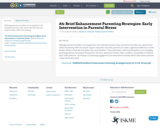
Although parents are often not recognized in the treatment process, they can be the ones who can improve their child’s functioning.
- Subject:
- Social Science
- Material Type:
- Lecture Notes
- Date Added:
- 06/14/2016

Although parents are often not recognized in the treatment process, they can be the ones who can improve their child’s functioning.

This course is for advanced students who wish to build confidence and skills in spoken English. It focuses on the appropriate oral presentation of material in a variety of professional contexts: group discussions, classroom explanations and interactions, and theses/research proposals. It is valuable for those who intend to teach or lecture in English and includes language laboratory assignments. The goal of the workshop is to develop effective speaking and listening skills for academic and professional contexts.

This course studies the relations of affect to cognition and behavior, feeling to thinking and acting, and values to beliefs and practices. These connections will be considered at the psychological level of organization and in terms of their neurobiological and sociocultural counterparts.

This course focuses on the practical applications of the continuum concept for deformation of solids and fluids, emphasizing force balance. Topics include stress tensor, infinitesimal and finite strain, and rotation tensors. Constitutive relations applicable to geological materials, including elastic, viscous, brittle, and plastic deformation are studied.

Students explore Hooke's law while working in small groups at their lab benches. They collect displacement data for springs with unknown spring constants, k, by adding various masses of known weight. After exploring Hooke's law and answering a series of application questions, students apply their new understanding to explore a tissue of known surface area. Students then use the necessary relationships to depict a cancerous tumor amidst normal tissue by creating a graph in Microsoft Excel.

After teaching your unit on stress and stress management, use this assignment for students to identify what their stressors are and how they manage them.
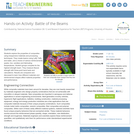
Students explore the properties of composites using inexpensive materials and processing techniques. They create beams using Laffy Taffy and water, and a choice of various reinforcements (pasta, rice, candies) and fabricating temperatures. Student groups compete for the highest strength beam. They measure flexure strength with three-point bend tests and calculations. Results are compared and discussed to learn how different materials and reinforcement shapes affect material properties and performance.
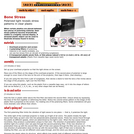
In this optics activity, learners examine how polarized light can reveal stress patterns in clear plastic. Learners place a fork between two pieces of polarizing material and induce stress by squeezing the tines together. Learners will observe the colored stress pattern in the image of the plastic that is projected onto a screen using an overhead projector. Learners rotate one of the polarizing filters to explore which orientations give the most dramatic color effects. This activity can be related to bones, as bones develop stress patterns from the loads imposed upon them every day.
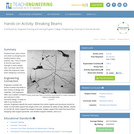
Students learn about stress and strain by designing and building beams using polymer clay. They compete to find the best beam strength to beam weight ratio, and learn about the trade-offs engineers make when designing a structure.
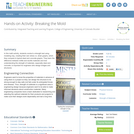
In this math activity, students conduct a strength test using modeling clay, creating their own stress vs. strain graphs, which they compare to typical steel and concrete graphs. They learn the difference between brittle and ductile materials and how understanding the strength of materials, especially steel and concrete, is important for engineers who design bridges and structures.
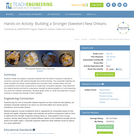
Students create and analyze composite materials with the intent of using the materials to construct a structure with optimal strength and minimal density. The composite materials are made of puffed rice cereal, marshmallows and chocolate chips. Student teams vary the concentrations of the three components to create their composite materials. They determine the material density and test its compressive strength by placing weights on it and measuring how much the material compresses. Students graph stress vs. strain and determine Young's modulus to analyze the strength of their materials.
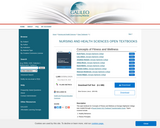
This open textbook for Concepts of Fitness and Wellness at Georgia Highlands College was created through a Round Seven ALG Textbook Transformation Grant.
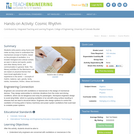
Students write poems using rhyme and meter as they come to understand the mechanical concept of rhythm, based on the principle of oscillation, in a broader biological and cultural context, as seen in dance and sports, poetry and other literary forms, and communication in general. Note: The literacy activities for the Mechanics unit are based on physical themes that have broad application to our experience in the world â concepts of rhythm, balance, spin, gravity, levity, inertia, momentum, friction, stress and tension.

In this lesson, students will be introduced to the concept of crisis. Students will gain an understanding of what crisis is, how it is different from regular stressful situations, and will be able to identify situations that can be categorized as crisis.
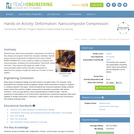
Students learn about nanocomposites, compression and strain as they design and program robots that compress materials. Student groups conduct experiments to determine how many LEGO MINDSTORMS(TM) NXT motor rotations it takes to compress soft nanocomposites, including mini marshmallows, Play-Doh®, bread and foam. They measure the length and width of their nanocomposite objects before and after compression to determine the change in length and width as a function of motor rotation.

Following the steps of the iterative engineering design process, student teams use what they learned in the previous lessons and activity in this unit to research and choose materials for their model heart valves and test those materials to compare their properties to known properties of real heart valve tissues. Once testing is complete, they choose final materials and design and construct prototype valve models, then test them and evaluate their data. Based on their evaluations, students consider how they might redesign their models for improvement and then change some aspect of their models and retest aiming to design optimal heart valve models as solutions to the unit's overarching design challenge. They conclude by presenting for client review, in both verbal and written portfolio/report formats, summaries and descriptions of their final products with supporting data.

This resource is a video abstract of a research paper created by Research Square on behalf of its authors. It provides a synopsis that's easy to understand, and can be used to introduce the topics it covers to students, researchers, and the general public. The video's transcript is also provided in full, with a portion provided below for preview:
"Every adult can make a difference in the lives of the young people around them Natural mentors -- extended family, neighbors, teachers, or friends -- who are trustworthy and consistent can help youth feel more confident and supported when facing stressful events A recent meta-analysis supports the vital role that caring adults play in kids' education, vocational performance, and emotional health, by fostering positive development and helping kids avoid the risks associated with the tumultuous years of adolescence Youth lacking these relationships can become isolated, and face psychological and emotional problems Teaching our kids ways to recruit natural mentors -- and encouraging adults to more freely share their social resources -- might just transform young lives Levi van Dam. “Does Natural Mentoring Matter? A Three Level Meta-analysis on the Association between Natural Mentoring and Youth Outcomes”. American Journal of Community Psychology (2018)..."
The rest of the transcript, along with a link to the research itself, is available on the resource itself.

As part of the engineering design process to create testable model heart valves, students learn about the forces at play in the human body to open and close aortic valves. They learn about blood flow forces, elasticity, stress, strain, valve structure and tissue properties, and Young's modulus, including laminar and oscillatory flow, stress vs. strain relationship and how to calculate Young's modulus. They complete some practice problems that use the equations learned in the lesson mathematical functions that relate to the functioning of the human heart. With this understanding, students are ready for the associated activity, during which they research and test materials and incorporate the most suitable to design, build and test their own prototype model heart valves.

This subject provides an introduction to the mechanics of materials and structures. You will be introduced to and become familiar with all relevant physical properties and fundamental laws governing the behavior of materials and structures and you will learn how to solve a variety of problems of interest to civil and environmental engineers. While there will be a chance for you to put your mathematical skills obtained in 18.01, 18.02, and eventually 18.03 to use in this subject, the emphasis is on the physical understanding of why a material or structure behaves the way it does in the engineering design of materials and structures.
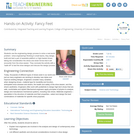
Students use the engineering design process to solve a real-world problem shoe engineering! Working in small teams, they design, build and test a pair of wearable platform or high-heeled shoes, taking into consideration the stress and strain forces that it will encounter from the shoe wearer. They conclude the activity with a "walk-off" to test the shoe designs and discuss the design process.